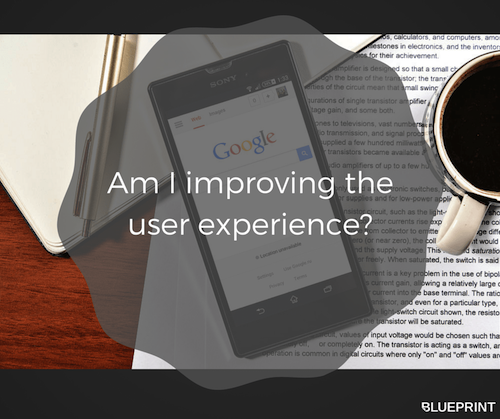The Question Every SEO Needs to Ask
Over the last decade, SEO has balanced between being a keyword stuffing game and buying backlinks by the thousands to structured data and blog, blog, BLOG. We SEOs used to have tons of “tricks” for getting sites to rank that are now considered black hat. (Which in my opinion, using black hat tactics to quickly “win” is just not worth it. The site is going to get caught and then at that point, redemption from de-indexation is a long and arduous journey. As a top Atlanta SEO agency, I can reassure you that Blueprint will NEVER engage in black hat tactics.)
What has this meant for the industry? A lot more guesswork really. Some tactics may work for one campaign that when brought to another, falls flat on its face. Even the best SEO teams are constantly trying to “crack the Google code” by adding more content, earning more links, adding rich snippets, analyzing Google Analytics data and so on. But should this really be such guesswork?
The goal of any SEO campaign, deliverable, effort, etc. needs to always come back to one central principle:
Is what I’m doing improving the user experience of my site?
If the answer is no, or you’re unsure, then you may need to reconsider it. After all, the myriad of changes that Google makes it to its algorithm is all aimed at providing the best answers to their users’ queries. Consider that in everything that Google touches and owns, Adwords revenue is still the majority of its income. This means that Google has to continue to provide the best search experience to continue generating the massive cash cow of pay-per-click, or it can count on losing that revenue stream to competitors.
So, if Google is always trying to a meet with consumer expectations and provide the answers to their queries, that means that we as online marketers need to do the same. The role of an SEO is simple. Everything we do should be aimed at answering our consumer’s top questions, in the way they want to receive that answer, and coded/optimized in a way that search engines can understand. Let’s break that down:
Answering consumer’s top questions
Sound easy doesn’t it? But how do you know what your consumer’s top questions really are? Are you using the right kind of language? Do your customers talk about your product using the same words as you and your company do? These are the types of questions that get answered with in-depth keyword research and strategy. And it needs to be done continuously. Of course Keyword Planner and Google Trends are great tools, but are you also using social listening to understand your consumers? We can surmise that Google uses similar data (after all we get most of it from them) to understand not only consumer questions but also the motivations behind them.

How consumers want the answer
Now that you’ve done the research of what questions to answer, what form of content will resonate best with your audience? Do your users want to discuss this in real time in social channels? Are they looking for how to videos and articles? What kind of imagery should accompany all those words on the page? Are you a local business and the only info they want is what’re your hours and address? Understanding how your audience wants to receive the answer to their question is vital. Moreover, they don’t want to wait for it. (Think about Google and its recent push for better mobile experience and faster loading pages.)
Crawl-able by search engines
Lastly, everything you do needs to be readable and measurable by search engines. This means having meaningful information architecture (and gasp! That’s good for users too. If a search engine can’t understand the content on your site and how it relates to one another, how is a user supposed to?), structured data to highlight the important facts (and once again, helps the user in SERPs), adding alt text to images to explain their relevance to the page and its content, etc. Design enhancements should be in place because they make the user experience that much more interactive and meaningful, not just to show off and flex some coding muscles. Overall, many of the “technical” aspects of SEO do have a consumer intention behind it, you just may need to dig a little deeper to find it.
Of course these three factors are heavy topics in and of themselves and deserve serious study. But, it’s important to keep that central role always in mind when doing any content creation, optimization, design, etc. If what you’re doing isn’t aimed at achieving one of those three goals, your time may be better spent elsewhere.



